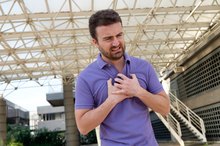Symptoms of a Broken Sternum
A sternal fracture is a cracked or broken sternum often caused by trauma -- commonly seen in vehicle accidents when the steering wheel hits the driver’s chest. The sternum, or breast bone, is the long vertical bone in the center of the chest. It is attached to the ribs, forming a protective enclosure for vital organs and tissue, including the heart and lungs. A diagnosis is typically made with chest X-ray or CT scan. The sternum will often heal on its own; however rest, medication and cold compresses also aid in healing. In some cases, this injury may be seen on visual examination. Seek immediate medical attention if you suspect you have a sternum fracture.
If you are experiencing serious medical symptoms, seek emergency treatment immediately.
Pain and Tenderness
Sternum fracture often causes chest pain and spasms in the center of the chest 1. Moving, coughing, sneezing or breathing heavily may exacerbate the pain. The area around the sternum, the midline of the chest, may be painful to touch. The area may begin to swell and have bruising. Damage to internal organs may also occur.
- Sternum fracture often causes chest pain and spasms in the center of the chest 1.
- The area may begin to swell and have bruising.
Difficulty Breathing
What Are the Treatments for a Broken Sternum?
Learn More
You may experience difficulty breathing with a fractured sternum. Breathing heavily may cause pain or an uncomfortable pressure. Difficulty breathing alone is not a symptom indicating a broken sternum. A chest X-ray and other symptoms signifying a sternal fracture has occurred are necessary to make a conclusive diagnosis.
- You may experience difficulty breathing with a fractured sternum.
Deformed Chest Area
Blunt force trauma often causes the sternum to break. The chest area may visibly be deformed indicating a sternum fracture has occurred. This injury may cause a bend or indentation of the chest that can be seen or felt.
Related Articles
References
- International Orthopaedics: Vertebral Fractures and Concomitant Fractures of the Sternum
- Healio Orthopedics: Acute Traumatic Sternum Fracture in a Female College Hockey Player
- Hong Kong Journal of Emergency Medicine: Sternal and Thoracic Spinal Fractures -- Case Reports of Two in One Accident
- Kumar NS, Bravian D, More AB. Xiphoid foramen and its clinical implication. Int J Anat Res. 2014;2:340-343.
- Gkantsinikoudis N, Chaniotakis C, Gkasdaris G, Georgiou N, Kapetanakis S. Morphological approach of the sternal foramen: an anatomic study and a short review of the literature. Folia Morphol (Warsz). 2017;76(3):484-490. doi:10.5603/FM.a2017.0006
- Khoriati AA, Rajakulasingam R, Shah R. Sternal fractures and their management. J Emerg Trauma Shock. 2013;6(2):113-6. doi:10.4103/0974-2700.110763
- Anderson BW, Burns B. Anatomy, thorax, xiphoid process. Treasure Island, FL: StatPearls Publishing. Updated December 9, 2018.
- Proulx AM, Zyrd TW. Costochondritis: diagnosis and treatment. Am Fam Physician. 2009;80(6):617-620.
- Yoo WG. Effects of combined chest expansion and breathing exercises in a patient with sternal pain. J Phys Ther Sci. 2017;29(9):1706-1707. doi:10.1589/jpts.29.1706
- Ayloo A, Cvengros T, Marella S. Evaluation and treatment of musculoskeletal chest pain. Prim Care. 2013;40(4):863-87. doi:10.1016/j.pop.2013.08.007
- Singh K, Anderson E, Harper JG. Overview and management of sternal wound infection. Semin Plast Surg. 2011;25(1):25-33. doi:10.1055/s-0031-1275168
- El-Ansary D, Lapier TK, Adams J, et al. An evidence-based perspective on movement and activity following median sternotomy. Phys Ther. 2019. doi:10.1093/ptj/pzz126
Writer Bio
Walter Davis has been a personal trainer and coach for nearly seven years. His background and education in the health care field include creating personal fitness and nutritional training for a variety of clients. Besides being an EMT, Davis has a bachelor's degree from Northeastern University.








